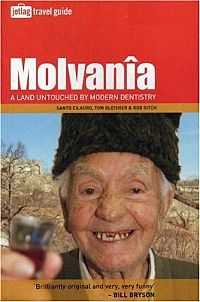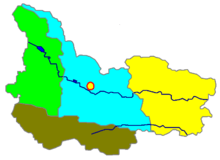Molvanîa
| Molvanîa | |
|---|---|
 Molvanîa: a Land Untouched by Modern Dentistry | |
| Author | Tom Gleisner; Santo Cilauro; Rob Sitch |
| Country | Australia |
| Language | English |
| Subject | Fictional country |
| Genre | Travel; comedy |
| Publisher | Jetlag travel guide |
Publication date | November 2003 (Australia)[1] |
| Media type | Hardcover |
| Pages | 176 |
| ISBN | 978-1-74066-110-2 |
| OCLC | 56672262 |
| Dewey Decimal | A827.4 21 |
| LC Class | PN6231.T7 C55 2003 |
| Followed by | Phaic Tăn |
| Republic of Molvanîa | |
|---|---|
 Map of Molvanîa | |
| Real-world | |
| Series | Molvanîa: a Land Untouched by Modern Dentistry |
| Creator | Tom Gleisner; Santo Cilauro; Rob Sitch |
| Genre | Parody |
| Fictional | |
| Capital | Lutenblag (Lutnblaag) |
| Language(s) | Molvanian |
| Government | Dictatorship |
| Prime Minister in Council | unnamed |
| Currency | Strubl (100 Qunts) |

Molvanîa (subtitled A Land Untouched by Modern Dentistry) is a book parodying travel guidebooks. The guide describes the fictional country Molvanîa, in Eastern Europe, a nation described as "the birthplace of the whooping cough" and "owner of Europe's oldest nuclear reactor". It was created by Australians Tom Gleisner, Santo Cilauro and Rob Sitch (locally known for The D-Generation and The Panel in Australia). The book has been criticized for promoting racist stereotypes against Eastern Europeans.
History
The book became a surprise success after its initial publication in Australia, sparking a bidding war for the international publication rights. Qantas has even run the half-hour video segment produced in association with the book on its international flights.[citation needed]
About Molvanîa
The Republic of Molvanîa is a composite of many of the worst stereotypes and clichés about Eastern Europe held by people in Australia (like Russkies, wogs or Hunyaks). The exact location of Molvanîa is never specified. It is said to border Germany, Slovakia, Slovenia, Hungary and Romania. The shape of the country with its divisions strongly suggests Moldova, and the name has similarities (as has the location description by the authors as "somewhere between Romania and downwind from Chernobyl"); it can also represent a composite country consisting of parts of Hungary, Czech Republic, Croatia, Serbia, Slovakia and perhaps Austria and Poland). The book mentions Bulgarians, Hungarians and perhaps Moldovans (ethnic Romanians) as its inhabitants: "The Molvanian population is made up of three major ethnic groups: the Bulgs (68%) who live predominantly in the centre and south, the Hungars (29%) who inhabit the northern cities, and the Molvs (3%) who can be found mainly in prison."
The book describes the nation as having been a desolate wasteland for much of its history, torn by civil war and ethnic unrest. Eventually Molvanîa's various warring factions were united as a single kingdom, ruled by a series of cruel despotic kings. In the late 19th century the monarchy was overthrown, but the royal family remained popular in exile. During World War II the country was allied with Nazi Germany, and then afterwards was occupied by the Soviet Union who set up a Communist puppet government. After the fall of European Communism in the 1990s, the country became a dictatorship run by a corrupt government with heavy ties to the Mafia.
Molvanîa is described as a very poor and rural country, heavily polluted and geographically barren. The infrastructure is terrible, with necessities such as electricity, clean water, and indoor plumbing being rare finds, largely due to bureaucratic incompetence. Though the travel guide tries to suggest otherwise, there is little to do in the country, the hotels are tiny, filthy and dilapidated, the ethnic cuisine disgusting, and the "tourist attractions" boring and overpriced.
The Molvanîan people are portrayed as being generally rude, dirty, and at times slightly psychotic, with numerous bizarre and illogical beliefs and traditions. The country's patron saint is Fyodor.
Language
The fictional Molvanîan language is said to be so complicated that it takes an average of 16 years to learn. Not only is the tone in which one speaks important to the meaning, but also the pitch. It is a gendered language, with different articles being used depending on whether a noun is masculine, feminine, neutral, or a type of cheese. There are language schools for tourists to attend, which are described by the book as a "waste of time."
Flag
The flag of Molvanîa is called the "Trikolor" despite the fact it only contains two colours, red and yellow. During the Soviet occupation, the flag had a yellow hammer and sickle in the top left corner. After the fall of Commuism, Molvanîa became one of the few ex-soviet states to retain the hammer and sickle but added a trowel into the symbol.[2]
Communications
Molvanîa does not have a regulatory authority for wireless communications, therefore the use of any frequency is permitted. At least one maker of Wi-Fi equipment has included Molvanîa as a choice that permits operation over a wider frequency range than is normally possible.[3]
Criticism
The book was criticized by the United Kingdom's former Minister for Europe Keith Vaz, who accused it of exploiting prejudices about Eastern Europe.
He said the book was a little "cheeky" because "it does reflect some of the prejudices which are taking root [in Europe]. He [Mr Gleisner] does try and show exactly where we are lacking in our knowledge, the sad thing is, some people might actually believe that this country exists."[4]
Sequels
Subsequent travel guide parodies published examine Southeast Asian nation Phaic Tăn (published 2004) and San Sombrèro in Latin America (published in 2006).
See also
- Elbonia
- Zladko Vladcik
- Syldavia
References
- ↑ "Laughs in land that dentistry forgot". Melbourne: The Age. March 6, 2004. Retrieved September 30, 2011.
- ↑ "Molvanîa: A Land Untouched by Modern Dentistry". www.molvania.com.au. Jetlag travel. November 2003. Retrieved November 30, 2012.
- ↑ "NS2 and Molvania or ComplianceTest". Ubiquiti Networks Forum. Ubiquiti Networks. July 10, 2009.
- ↑ "Molvania spoof mocks travel books". BBC News. April 2, 2004. Retrieved September 30, 2011.